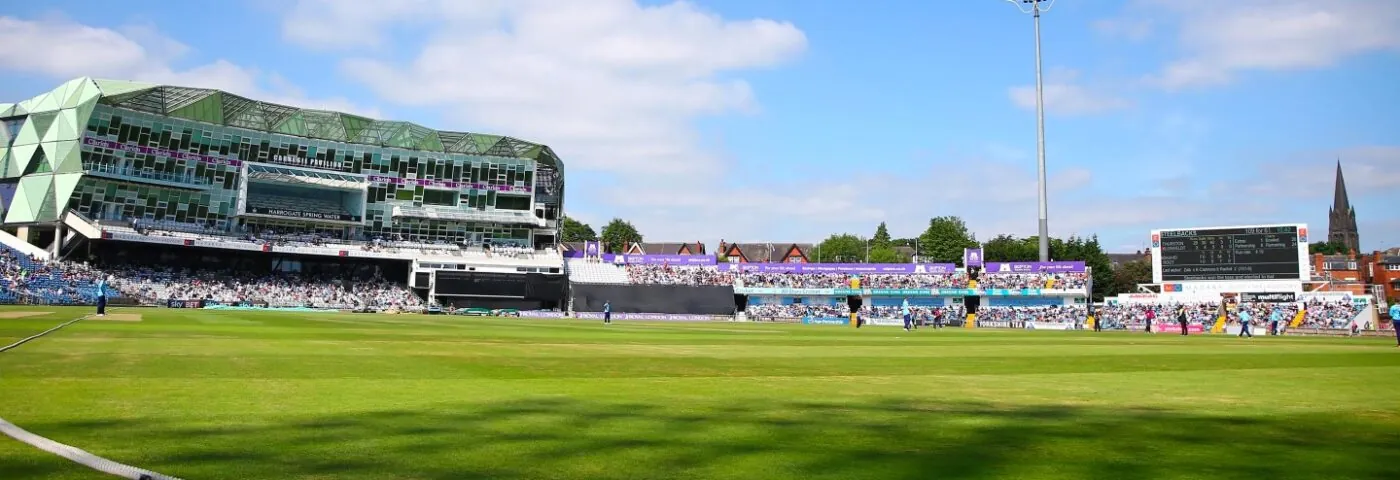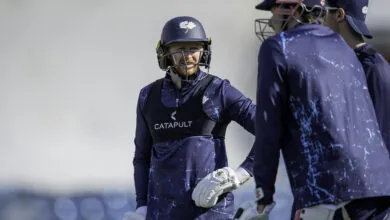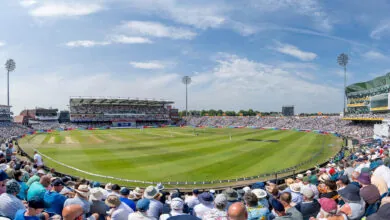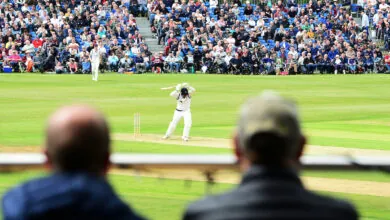The very first Roses match took place in 1849 before either of the official county clubs had been formed; the official series started in 1867. Paul Dyson looks back at a low-scoring game in the 1970s. The photo of Richard Hutton, taken in 1971 (the year of this featured game), comes courtesy of Mick Pope.
May 29, 31, June 1 1971 at Old Trafford: Lancashire 168 (RA Hutton 6-38) & 75 (RA Hutton 5-24); Yorkshire 79 (P Lever 5-27) & 103-6. Match drawn.
Despite being in transition, Yorkshire had finished in a creditable fourth place in the County Championship in 1970. The response from the county’s heirarchy was to sack the captain, Brian Close, and to appoint Geoff Boycott in his place. Of their opening five games in 1971 two were won and one lost. Lancashire had finished the previous season in third place – one higher than their Roses rivals – but had become a real force in one-day cricket. The Sunday League had started in 1969 and the Red Rose county had won the first two competitions as well as the Gillette Cup in 1970, it thus becoming the first county to win two trophies in one season. Its Championship results at the start of 1971 were identical to those of Yorkshire.
Although the game began with the weather looking dubious the hosts decided to bat on winning the toss. Two wickets for Richard Hutton and two catches for David Bairstow saw them slip to 21 for three but Ken Snellgrove (37) and Indian wicket-keeper Farooq Engineer (49) then shared a half-century stand for the fifth wicket. Thereafter wickets fell regularly and when Peter Lever was ‘c Bairstow b Hutton’ it made it six for both Yorkshire players – six catches for Bairstow and figures of six for 38 for Hutton. The occasional showers were keeping the pitch fresh but, when Yorkshire batted, that did not contribute to Boycott being run out for nine though the cautious approach meant that after 22 overs the score had reached 43 for two.
Day two started with Yorkshire losing their third wicket without addition to the total. Worse was to come when 61 for three soon became 64 for nine! Six wickets for three runs! It was a result of the contrasting pace of Lever (five for 27) and the left-arm spin of David Hughes (three for ten in eight overs). Geoff Cope was then the fourth batsman to make it into double figures and the tenth wicket stand took the score to 79. A storm ended play early, Lancashire having made three for one.
The final day began with more wickets tumbling. The home side fell to 36 for six before Jack Simmons made 20 to help push the all-out total up to 75. Although Hutton (five for 24) was again the main wicket-taker (very impressive match figures of 11-62) four went to spin (two each for Don Wilson and Cope). Yorkshire’s target was 165 and about three hours remained. Boycott was absent ill but John Woodford (32) and John Hampshire (44) shared 58 for the second wicket. However they had – again – batted slowly and it appeared that the visitors had decided not to press for victory. By the close of play they had scored 103 for six, the runs having been scored at a mere two per over.
Yorkshire won only two more Championship games throughout the rest of the summer and finished in 13th place – equalling the lowest position in their entire history. Lancashire, though, repeated their third-place finish of the previous season and again won the Gillette Cup to reinforce their expertise in the shorter form of the game.
Man of the Match
Richard Hutton had three years in the first eleven at Repton School and this early experience was followed by first-class cricket at Cambridge University where he gained three Blues from 1962 onwards. This was also the year in which he made his Yorkshire debut but he never gained a regular place in the team until 1968. Thereafter his consistent batting and bowling developed so well that his success brought him five Test caps in 1971. In the following winter he toured Australia with the Rest of the World.
The elder son of Sir Leonard, Hutton was, like his father, born in Pudsey – in 1942 – and eventually became a genuine all-rounder. Tall, he used his six feet, four inches of height to often achieve awkward lift and bounce and his use of seam and swing would make him a threat in conducive conditions. As a batsman he stood upright in his stance and hit very powerfully as well as having a stylish off-drive. He was also an excellent slip-fielder.




